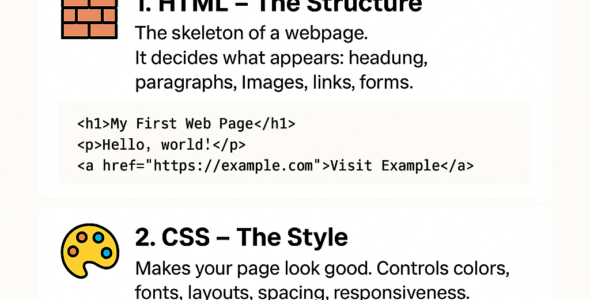Welcome to the world of web development! In this first module, we’ll introduce you to the foundation of the web: HTML. HTML, or HyperText Markup Language, is the standard markup language used to create web pages. It’s the backbone of a website, providing the structure and content that the web browser renders to the user.
Imagine building a house. You need a strong foundation to support the walls, roof, and all the finishing touches. HTML is that foundation. It provides the basic structure of a web page, including headings, paragraphs, images, links, and more.
In this module, we’ll explore the history of HTML, its basic syntax, and the essential elements that make up an HTML document. We’ll also discuss the importance of HTML in web development and how it works with other technologies like CSS and JavaScript.
History of HTML
HTML was first introduced in 1993 by Tim Berners-Lee, the inventor of the World Wide Web. Since then, it has undergone several revisions, with the latest version being HTML5. HTML5 offers new features and improvements that make it easier to create interactive and engaging web pages.
Basic HTML Syntax
HTML syntax consists of a series of elements, represented by tags. Tags are surrounded by angle brackets (<>) and usually come in pairs, with the opening tag preceding the content and the closing tag following the content. For example, the paragraph element is represented by the opening tag
and the closing tag .
Essential HTML Elements
Here are some essential HTML elements you’ll need to know:
- Headings (h1-h6): Define headings on a web page
- Paragraphs (p): Define paragraphs of text
- Links (a): Create hyperlinks to other web pages or email addresses
- Images (img): Add images to a web page
- Lists (ul, ol, li): Create unordered and ordered lists
Importance of HTML
HTML is crucial in web development because it provides the structure and content of a web page. Without HTML, a web page would be a blank canvas, lacking any meaningful content or organization. HTML also works seamlessly with CSS (Cascading Style Sheets) and JavaScript to create a complete web page.
CSS is used to control the layout and visual styling of a web page, while JavaScript adds interactivity and dynamic effects. Together, these three technologies form the foundation of web development.
Conclusion
In this first module, we’ve introduced you to the basics of HTML, including its history, syntax, and essential elements. We’ve also discussed the importance of HTML in web development and how it works with other technologies. As you progress through this course, you’ll learn more about HTML and how to use it to create stunning web pages. Remember, HTML is the foundation of a website, and a strong foundation is essential for building a robust and engaging web presence.”

